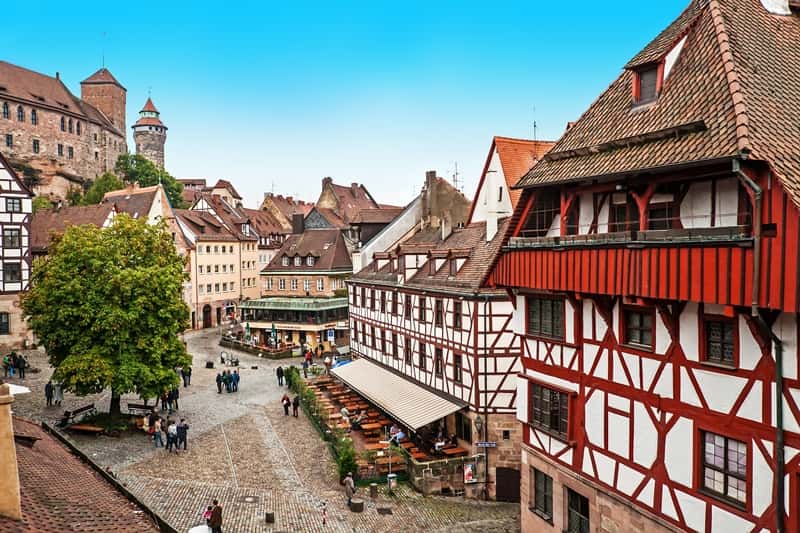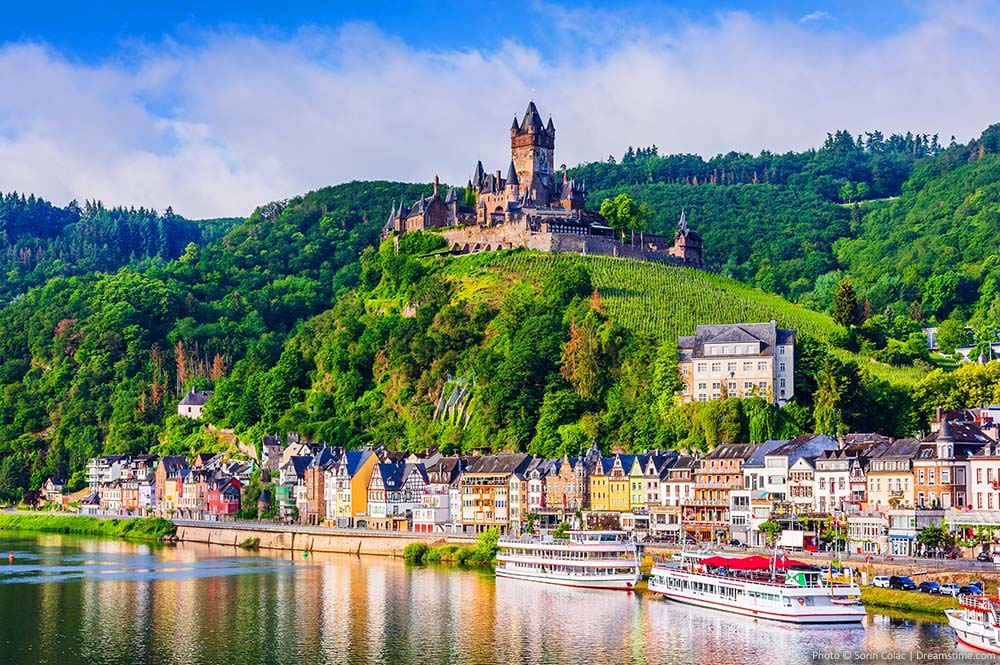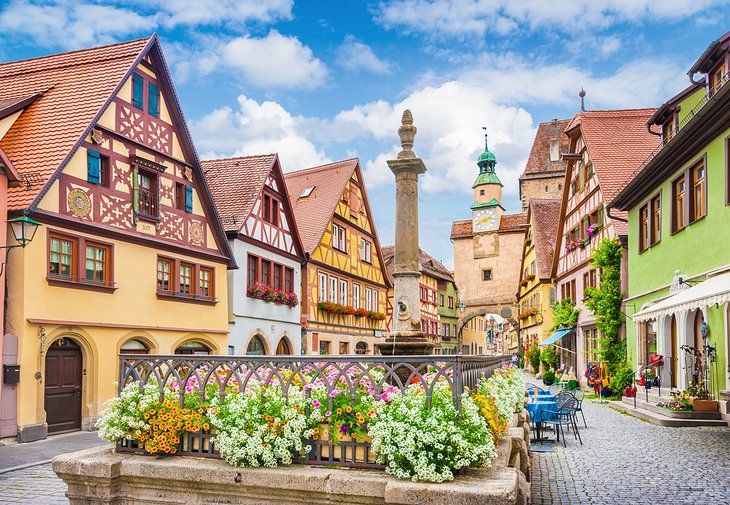CASTLE VISITS: A TRIP THROUGH NORTHERN GERMANY
When driving at high speeds on Germany’s autobahns, time seems to fly by. It is I, in fact, who is doing the soaring. The BMW 745i’s speedometer is currently showing 160 km/h (100 mph) and rising, but the car is so stable that I feel like I’m only traveling 60 mph.
Cars like Audis and BMWs zoom past us like we’re not even there. Given that the highway is in excellent condition and speed limits do not yet exist on some of Germany’s less traveled highways, I decided to let the BMW do what it does best and press on with the gas.
Thankfully, my mother, who is riding shotgun, is focused on what’s happening outside the window and not on my pace. The scenery is picture-perfect. The landscape is dominated by fertile farmland that has been stripped bare after harvest. Huge pieces of farm machinery are scattered throughout the fields, and farmers are working hard to get them ready for next year’s harvest.
The sky is blue above and the sun is shining brightly. Having this exquisite automobile and being in Germany today couldn’t be better.
This technological marvel is not, alas, mine to own. My German buddy Torsten owns the BMW and kindly let me and my mom borrow it for our girls’ road trip. But this isn’t your ordinary road trip; we haven’t packed any maps. Our only map is the one on the car’s GPS system.
In the northern city of Hamburg, Torsten gave us a brief driving lesson before sending us on our way with best wishes. A woman’s voice, speaking in polished High German, directed our course through the crowded streets. We were on our way out of town in under 45 minutes, despite my needing to brush up on my language (the German I learnt in school in Austria came in helpful!).
Our current goal is to spend five days traveling throughout Mecklenburg-Vorpommern, a state in Germany that was formerly a part of East Germany. Along the route, we’ll be staying in castle-themed hotels.
Mecklenburg-West Pomerania has a relatively small population of 1.7 million despite being the sixth largest state in Germany. With its proximity to the Baltic Sea and plenty of lakes inland, this region is a popular vacation spot for Europeans. However, for some reason, not many people from the United States visit this area. This is also my first time in this part of the world, and I’m starting to wonder what took me so long to come here.
Schwerin, Germany, population 96,500, is our first visit; it’s located around 70 miles (112 kilometers) east of Hamburg. Schwerin, the capital of Mecklenburg-Western Pomerania, is well-known for its castle, which sits on an island in the midst of Lake Schwerin and seems like something out of a fairy tale.
DISCOVER GERMANY: TRAVEL IDEAS IN GERMANY
Schwerin Castle is the epitome of a great castle, with its golden towers and lofty turrets. In the 16th and 17th centuries, the fortress was transformed into a palace after serving as the seat of the Grand Duchy of Mecklenburg-Schwerin. As we move from room to room, our guide recounts the lives of bygone aristocrats. Our eyes get tired from looking up at the ceiling paintings, and our American brains reel with all the history we just learned about.
We pause for lunch at Zum Stadtkrug, a local brew bar, to bring ourselves back to reality after a whirlwind of new information. Brewmaster Hans-Ulrich Trosien chats with us for a while, delving into the nitty-gritty of beer production and providing us with tasters of his robust black ale. After stuffing ourselves with hearty German fare, we return to our reliable BMW and drive to our very own castle, if only for a few days.
We got lost in the country and ended up 20 minutes outside of Schwerin at the end of a dirt road bordered with trees, but we found Schloss Basthorst in the end. Schloss Basthorst, like many East German castles, was abandoned for decades during communist administration. But now it’s been transformed into a chic boutique hotel.
Schloss Basthorst is more of a great manor than a castle, with its red brick and open-timbered rooms and the refined air of a magnificent old woman. In addition to my mother and me, there is a small group of German businessmen staying here. The night is so lovely that instead of holding meetings inside, people are holding candlelit conversations in the backyard gardens, the gentle sound of their laughter drifting up to our windows on the cool night air.
We go for Wismar, a Baltic Sea port town, first thing the following morning. Wismar, a Hanseatic town from 1259 and a UNESCO World Heritage site dating back to the 1220s. Wismar fell to the Swedish troops in 1632. About 150 years of Swedish rule left their mark on the area, including a distinct Nordic appearance in some residents, the yearly Schwedenfest (Sweden Festival), and the persistence of a few Swedish terms in everyday use.
Our day’s guides, Guenther Faust and Dallas Reese, teach me all this and more. I tag along with English expat Dallas and my mother while Guenther explains the town’s history as best he can in basic German that I can understand.
The tower of the Church of Mary stands at an impressive 262 feet (80 meters), and we also take some time to visit the ruins of St. George, a cathedral that was destroyed by American bombs and is scheduled to reopen in 2010. But my favorite place to go is the bakery down the street. The four of us sit around a tiny outdoor table, where we share tortes and Berliner (German doughnuts) and laugh and chat because I’ve been craving German sweets ever since we arrived.
The moment has come to hit the road once more. After two hours on the road, during which we saw nothing but farms and small towns, we finally arrived at Schlosshotel Gutshaus Ludorf. The hotel, which opened in 1698 and was designed in the Danish brick renaissance style, enjoys a prime location on the western bank of the Müritz River. Keril and Manfred Achtenhagen painstakingly renovated the manor, which was formerly a rundown medical facility.
They’ve recovered a number of valuable artifacts, including some antique ceiling murals that had been covered up by decades of paint. The manor’s 23 bedrooms are all uniquely decorated, and some even have exposed-wood ceilings. Our room rate, like that of many German hotels, includes a hearty continental breakfast. My mother is relieved to find that our hotel hosts speak English fluently, as do the vast majority of Germans we have encountered thus far.
As a result of the abundance of lakes in the area, the Müritz Nature Reserve has earned the moniker “land of a thousand waters,” and Gutshaus Ludorfis is located directly across the street. During our stroll across the neighborhood this afternoon, we encounter cyclists, hikers, and boaters enjoying the outdoors. We then move on to the neighbouring community of Ludorf, which has no more than 50 permanent structures. A unique 14th-century octagonal church serves as the community’s focal point. The entire church may be traversed in 20 steps at most.
We’ll spend the afternoon in Waren, a picturesque city that has thrived since the fall of communism. The pedestrian district is lined with colorfully painted homes and hip cafes and stores. We get ice cream and enjoy it in the sunshine. Our Albanian server raves about this region of Germany, and I can certainly see why. The city of Waren is the perfect size, making it easy to get around on foot and offering convenient access to all of life’s necessities.
The town of Klink, located on Lake Müritz and only 40 minutes away, is where the fun begins. Although Tokon Sports often organizes outings for large groups, they graciously agree to take us on a speedboat tour of the lake. From this vantage point, the seaside village appears little, and the thrill of swiftly crossing the water is exhilarating.
The members of Tokon’s young staff may not have even been alive during the region’s communist rule. I really appreciate being around them because of the new perspective on life and the home country that they bring to the table.
They bring us to the spa and resort that was formerly a massive castle called Schlosshotel Klink. This castle is more business-oriented, offering event space for weddings and conferences. With a view of the lake from the castle’s deck, we enjoy a meal of fresh fish. From up here, one may easily imagine themselves to be royalty.
Our final day is spent in Güstrow, a charming town of 31,000 on the Nebel River about an hour’s drive from our current location. Parts of it, like many former East German towns, have been repaired and modernized, while other buildings remain in disrepair, waiting for owners with the will and means to bring them back to life.

After seeing the sights in the downtown area, we head to the majestic Palace Güstrow, a museum that deserves far more time than we have. The dukes of Mecklenburg lived in this renaissance fortress, which was constructed in 1589. Restoration work began in 1963 and was finished in 1981. It had fallen into disrepair during war and communist rule.
The Schwebende Engel (Hovering Angel), a memorial to the soldiers who lost their lives in World War I and installed in the city’s cathedral by expressionist artist Ernst Barlach in 1926, is the main draw for visitors to the brick Gothic church, which was constructed between 1226 and 1335.
The Neubert sisters, our tour leaders, join us for lunch afterward. One grew up in West Germany and the other in East Germany, their lives forever divided by the Berlin Wall. After being separated for many years due to the Berlin Wall, the family was finally reunited when Germany was reunified.
When I return to Germany, I am always astounded by how much has changed. My mother and I are driving back to Hamburg when we see a single, German flag flying from a window. It must have been at least 10 feet (3 meters) in length. Most people don’t think twice about showing their national pride when they see their flag flying, but Germans have long been wary of doing so out of embarrassment for the country’s Nazi past.
But now it appears that Germany is finally allowing itself to take pride in its many achievements. In the last few decades, they’ve combined two distinct nations and worldviews into a single state, with the more powerful side supporting the weaker side until it could stand on its own.
And after spending the past week traveling around the villages of what was formerly East Germany, I can’t help but be proud of their achievements.





